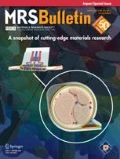
Water transport in polyamide-based reverse osmosis membranes using 3D models obtained from energy-filtered transmission electron microscopy and electron tomography. Credit: Ganapathysubramanian group@ISU and Gregony Foss@TACC.
Different technologies have been implemented for water purification to alleviate the substantial stress on existing water sources. Reverse osmosis (RO) is currently one of the leading processes for water purification and has seen significant progress in the development of energy efficient desalination membranes using polyamide (PA) active layers. It is known that biological membranes rely on their internal nanoscale structures to achieve high permeabilities while maintaining their selectivity. However, the link between nanoscale PA morphology and membrane performance in desalination membranes was still not well understood.
Researchers from The Pennsylvania State University, The University of Texas, Iowa State University of Science and Technology, DuPont Water Solutions, and Dow came together to quantify the effects of three-dimensional (3D) nanoscale variations in polymer mass on water transport within PA-based RO membranes. A total of four PA-based RO membranes were synthesized by conventional interfacial polymerization directly on a porous polysulfone support membrane with varying processing conditions, but retained similar chemical composition. As reported in a recent issue of Science (https://doi.org/10.1126/science.abb8518), nanoscale density variations are prejudicial to water transport and must be controlled to maximize the performance of these RO membranes.
Using a combination of scanning transmission electron microscopy with a high-angle annular dark-field detector (STEM-HAADF), the researchers determined the nanoscale 3D distributions of both PA density and thickness. From the 3D nanoscale intensity distributions, they determined the nanoscale distributions of density (ρ) within the PA films, from which fractional free volume (sFFV) and water diffusivity (Dw) could be calculated. Determining where the polymer is concentrated was critical to understand how water passes through the membrane.
The mean free path of electrons was used to determine the average values of PA thickness, which could then be used with tomogram data to establish density (ρavg), diffusion coefficient (Dw,avg), and sFFV (sFFVavg). An increase in water permeance was correlated with a decrease in ρavg and an increase in sFFVavg. Also, as water permeance increased, a simultaneous increase in Dw,avg was observed, following the expected trend of the solution-diffusion model.
Nonetheless, researchers also found that average values alone cannot reliably predict transport properties. For example, the spatial arrangement of localized membrane resistance variations could affect the diffusion pathways and cause distributions in flow. Additionally, calculation results from average values predicted an increase in water flux with increasing thickness instead of the decrease seen in experiments.
Accurate predictions of transport properties were achieved by calculating water diffusion through 3D models. Regions of high PA density and low sFFV showed ultralow water diffusivity. The regions of greatest resistance were near the PA top surface, and variations in water diffusion pathways in x and y directions were observed to avoid these areas.
All the membranes studied showed some local inhomogeneities in water flux, but the membrane with the highest flux minimized low-flow regions. Results suggest that nanoscale PA morphology affects water transport in all three dimensions and that highly permeable membranes minimize mass fluctuations. These suppress water permeability while maintaining the selectivity of the membrane. The research group proposed that a minimum average PA density exists that enables monovalent salt selectivity for suitable desalination.
Principal investigator Manish Kumar, from The University of Texas at Austin, told MRS Bulletin that “the main findings in this study include the ability to determine density differences and free volume distributions in dense polymer layers. It provides a way to connect the structure of dense films to transport across them.”
“All kinds of membranes can use the tomography and reconstruction techniques demonstrated in this study, from virus ultrafiltration membranes to gas separation membranes. We expect that manufacturers and scientists will use these techniques to study chemistry-structure–property relationships in different kinds of dense membranes used for separations,” Kumar says.
In a perspective published in the same issue of Science (https://doi.org/10.1126/science.abe9741), Geoffrey M. Geise from the University of Virginia says that “the approach reported by Culp et al. may be useful for informing the design of, and directly measuring the impact of, antifouling coatings or other membrane surface treatments that are commonly used to prevent biofouling or reduce membrane degradation.” Furthermore, he thinks that the “HAADF-STEM technique could be a key step toward answering questions that have lingered for decades about how polyamide-based RO membranes function.”
Author information
Authors and Affiliations
Rights and permissions
About this article
Cite this article
Santiago-Maldonado, X. Nanoscale morphology control enhances water transport in polymer desalination membranes. MRS Bulletin 46, 298–299 (2021). https://doi.org/10.1557/s43577-021-00090-8
Published:
Issue Date:
DOI: https://doi.org/10.1557/s43577-021-00090-8

